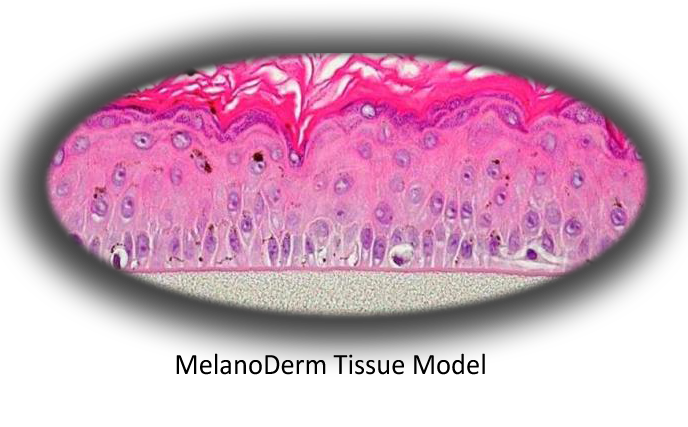Pigmentation Studies
The Model
MatTek's MelanoDerm™ System consists of normal, human-derived epidermal keratinocytes (NHEK) and melanocytes (NHM) which have been cultured to form a multilayered, highly differentiated model of the human epidermis. The NHM within co-cultures undergo spontaneous melanogenesis leading to tissues of varying levels of pigmentation. The tissues are produced using serum free medium without artificial stimulators of melanogenesis such as TPA and IBMX. The cultures are grown on cell culture inserts at the air-liquid interface, allowing for topical application of skin lighteners or self-tanning agents, providing a useful in vitro means to evaluate cosmetic and pharmaceutical agents designed to modulate skin pigmentation. For more information on MelanoDerm, click here.

Technical References

698. EBSELEN IS A NEW SKIN DEPIGMENTING AGENT THAT INHIBITS MELANIN BIOSYNTHESIS AND MELANOSOMAL TRANSFER. Kasraee1, B., Nikolic1, D.S., Salomon1, D., Carraux1, P., Fontao1, L., Piguet1, V., Omrani2, G.R., Sorg1,3,O., and Saurat1,3, J-H. 1Department of Dermatology, Geneva University Hospital, Geneva, Switzerland; 2Endocrinology and Metabolism Research Center, Nemazee Hospital, Shiraz University of Medical Sciences, Shiraz, Iran; 3Swiss Centre for Applied Human Toxicology (SCAHT), Geneva, Switzerland. Experimental Derm., 21, 19-24, (2011).
695. HYPERPIGMENTATION IN HUMAN SOLAR LENTIGO IS PROMOTED BY HEPARANASE-INDUCED LOSS OF HEPARAN SULFATE CHAINS AT THE DERMAL–EPIDERMAL JUNCTION. Iriyama, S., Ono, T., Aoki, H., Amano, S. Shiseido Research Center, 2-2-1 Hayabuchi, Tsuzuki-ku, Yokohama 224-8558, Japan Journal of Dermatological Science, 64, 223–228, (2011).
620. THE FIBROBLAST-DERIVED PARACRINE FACTOR NEUREGULIN-1 HAS A NOVEL ROLE IN REGULATING THE CONSTITUTIVE COLOR AND MELANOCYTE FUNCTION IN HUMAN SKIN. Choi1, W., Wolber2, R., Gerwat2, W., Mann2, T., Batzer2, J., Smuda2, C., Liu3, H., Kolbe2,L. and Hearing1, V.J. 1Laboratory of Cell Biology, National Cancer Institute, National Institutes of Health, Bethesda, MD 20892, USA 2R&D, Skin Research, Beiersdorf AG, Hamburg, 20245, Germany 3Department of Biostatistics, Bioinformatics, and Biomathematics, Georgetown University Medical Center, Washington, DC 20007, USA. J. of Cell Science, 123, 3102-3111, 2010.
522. A LOTION CONTAINING UNDECYLENOYL PHENYLALANINE AND ERGOTHIONEINE REDUCES MELANIN LEVELS WITHOUT AFFECTING TISSUE VIABILITY IN ARTIFICIAL SKIN CONSTRUCTS. Dong, K., Yarosh, D., Smiles, K., and Markova, N. AGI Dermatics, Freeport, NY, US. J Am Acad Dermatol, March 2009.
470. DICKKOPF 1 (DKK1) REGULATES SKIN PIGMENTATION AND THICKNESS BY AFFECTING WNT/â-CATENIN SIGNALING IN KERATINOCYTES. Yamaguchi1,2,3, Y., Passeron1, T., Hoashi1, T., Watabe1, H., Rouzaud1, F., Yasumoto1, K., Hara1, T., Tohyama2, C., Katayama2, I., Miki1, T., and Hearing1, V.J. 1Laboratory of Cell Biology, National Cancer Institute, National Institutes of Health, Bethesda, Maryland, USA; 2Department of Dermatology, Osaka University Graduate School of Medicine, Osaka, Japan; and 3Department of Geriatric and Environmental Dermatology, Nagoya City University Graduate School of Medical Sciences, Nagoya, Japan. FASEB J., 22, 000–000 (2008).





www.MatTek.co.kr